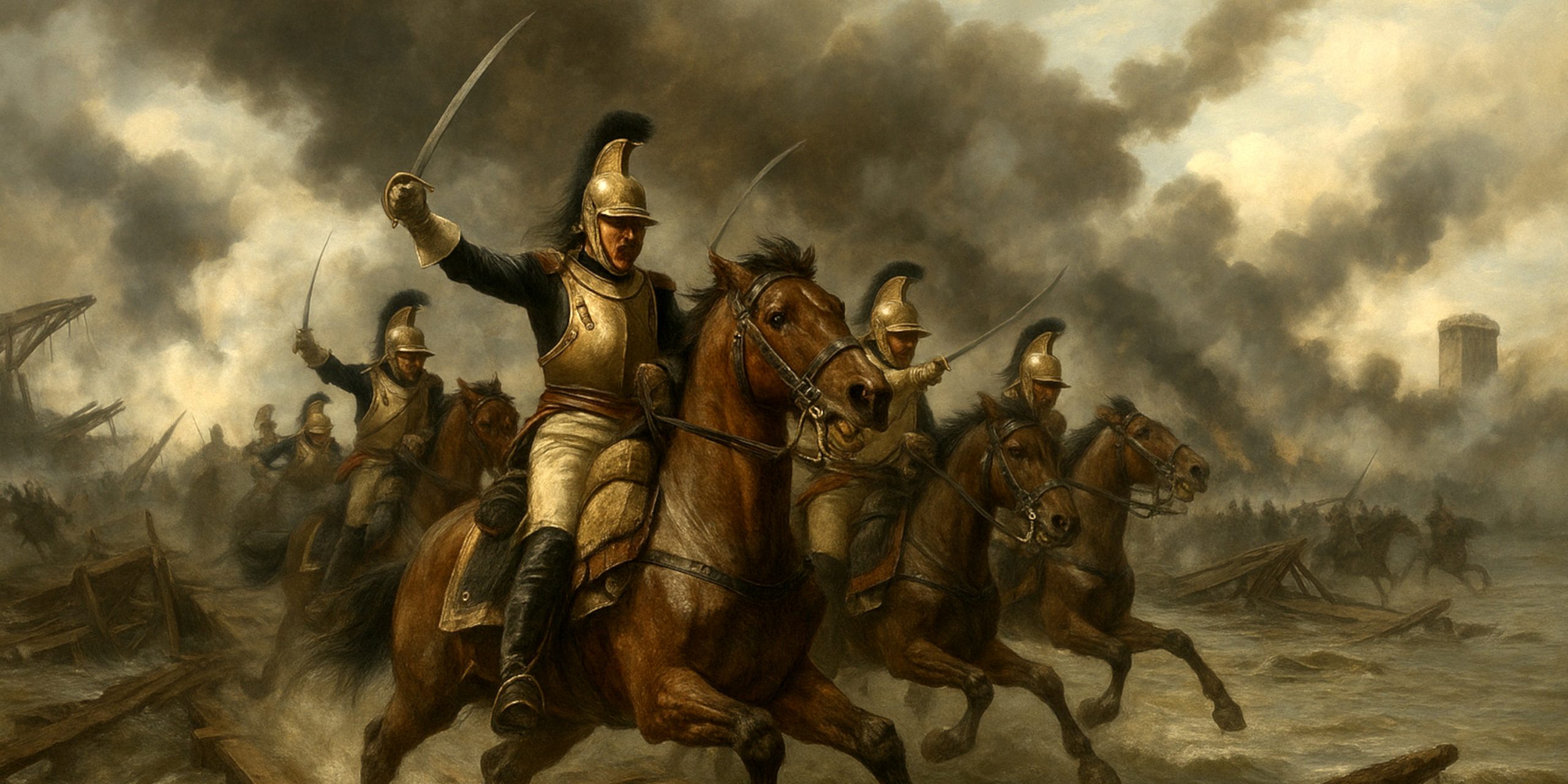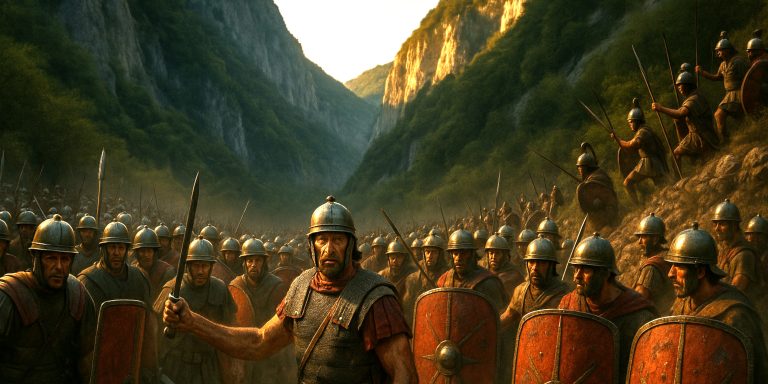
The Battle of Aspern-Essling, fought on 21–22 May 1809, was Napoleon’s first serious check in the field. It took place near Vienna on the banks of the Danube, during the War of the Fifth Coalition. Here, the Emperor’s habitual confidence met a hard limit imposed by geography, Austrian grit, and sheer logistical chaos. The swollen river, a flimsy bridge, and an unexpectedly stubborn Archduke Charles combined to deliver Napoleon something he hadn’t tasted since Egypt: defeat.
It is a fascinating encounter, less for its sweeping manoeuvres and more for its confusion, improvisation, and raw violence on the plains of Lobau.
Background
After capturing Vienna in early May 1809, Napoleon sought to cross the Danube to crush the main Austrian army led by Archduke Charles. Using the island of Lobau as a stepping stone, he ordered the construction of pontoon bridges to reach the northern bank near the villages of Aspern and Essling.
The river, swollen by spring meltwater, was treacherous. Barges, debris, and Austrian fireships repeatedly broke the bridges. It was a disaster in slow motion. Napoleon, usually a master of tempo, found himself cut off mid-battle from his reserves and supplies.
Forces
| Faction | Commander | Strength | Artillery | Cavalry |
|---|---|---|---|---|
| French Empire | Napoleon Bonaparte | Approx. 70,000 men | Around 200 guns | 10,000 cavalry |
| Austrian Empire | Archduke Charles of Austria | Approx. 95,000 men | Around 300 guns | 14,000 cavalry |
Both armies were veteran forces, but the Austrians had learned hard lessons from earlier defeats. Their restructured army was better drilled, better led, and crucially, they had a solid defensive position along the floodplain.
Leaders and Troop Composition
French Empire
- Commander-in-Chief: Napoleon Bonaparte
- Corps Commanders:
- Marshal Jean Lannes (II Corps)
- Marshal André Masséna (IV Corps)
- General Jean-Baptiste Bessières (Cavalry Reserve)
- Marshal Jean-Baptiste Bernadotte (Saxon contingent, late arrival)
- Key Units:
- 2nd Corps (Lannes) – veterans of Austerlitz and Jena
- 4th Corps (Masséna) – strong infantry under Boudet and Legrand
- Imperial Guard – elite infantry and heavy cavalry in reserve
Austrian Empire
- Commander-in-Chief: Archduke Charles of Austria
- Corps Commanders:
- Johann von Hiller
- Heinrich von Bellegarde
- Prince Rosenberg-Orsini
- Archduke John (arriving too late)
- Key Units:
- Infantry divisions from Bohemia and Moravia
- Strong heavy cavalry under Liechtenstein
- Grenadiers and Hungarian regiments in reserve
Arms and Armour
French Forces
- Infantry: Standard issue Charleville Model 1777 musket, bayonet fixed more often than not in the close quarters of village fighting.
- Cavalry:
- Heavy Cavalry (Cuirassiers): Model 1801 cuirassier sabre, steel cuirass chestplate and helmet.
- Light Cavalry (Hussars, Chasseurs): Light curved sabres (AN XI light cavalry sabre).
- Artillery: 6-pounder and 12-pounder Gribeauval guns, noted for rapid redeployment even on muddy terrain.
Austrian Forces
- Infantry: 1798 pattern musket, robust but slower to reload than French equivalents.
- Cavalry:
- Heavy Cavalry (Kürassiere): Straight Pallasch sabres and breastplates.
- Hussars and Uhlans: Hungarian light sabres and long lances.
- Artillery: Heavier calibres, though cumbersome, gave an advantage in defensive firepower.
The fighting in Aspern and Essling villages became almost medieval in character, with bayonets, sabres, and even musket butts used in the narrow streets and burning barns.
Battle Timeline
21 May 1809 – The French Assault Begins
- Morning: Napoleon’s troops begin crossing the Danube via the fragile pontoon bridges.
- Midday: Masséna’s corps occupies Aspern while Lannes seizes Essling.
- Afternoon: Archduke Charles attacks in force. The French line holds, but only just. Repeated bridge breaks slow reinforcements.
- Evening: Fighting devolves into brutal house-to-house combat. Both villages change hands multiple times.
22 May 1809 – The River Turns Against Napoleon
- Dawn: The Austrians renew their assault. The French right under Lannes pushes them back temporarily.
- Midday: The main bridge collapses again. Napoleon’s army is effectively stranded.
- Afternoon: The Austrians counterattack across the entire front. Lannes is mortally wounded by a cannonball.
- Evening: With no hope of resupply, Napoleon orders a withdrawal to Lobau.
The Emperor had lost around 23,000 men. The Austrians, about 22,000. It was a bloody stalemate that history treated as a defeat for France, simply because Napoleon had failed to win.
Contemporary Quotes
“Never was there seen such slaughter. The Danube ran red with blood.” – French officer, after the battle.
“At Aspern, the fortune of war turned her face from the Emperor.” – Austrian chronicler, 1809.
“Lannes was the Roland of my army. I have lost a friend and the bravest of men.” – Napoleon Bonaparte, upon hearing of Lannes’ death.
Archaeology and Remains
The battlefield of Aspern-Essling, now part of Vienna’s suburbs, has yielded fascinating finds. Archaeological surveys in the early 2000s uncovered musket balls, uniform buttons, sabre fragments, and French cuirassier helmets dented by musket fire. A preserved mill building at Essling still bears cannonball scars.
The Aspern-Essling Museum in Vienna displays relics, including sections of the original bridge chain links and personal effects of Marshal Lannes. Annual commemorations still take place nearby, attended by re-enactors in full Napoleonic uniform.
Legacy
Aspern-Essling was a psychological shock to Napoleon’s image of invincibility. It proved that the Austrian army could learn, adapt, and hold its ground. The Emperor would avenge himself weeks later at Wagram, but even there, the shadow of Aspern lingered.
For the historian, it marks the beginning of the end for the Napoleonic illusion of effortless dominance. The cracks in the empire had appeared, and they started on the muddy banks of the Danube.
Watch the documentary:



